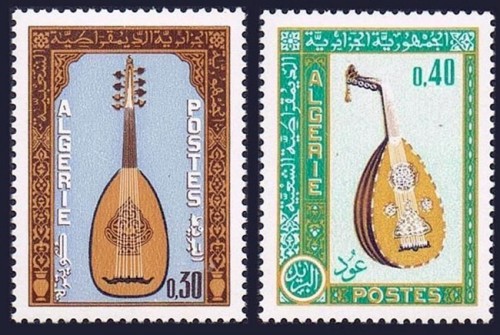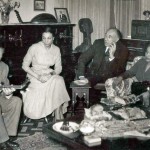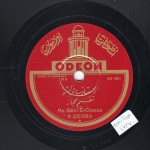The Arab Music Archiving and Research foundation (AMAR), in collaboration with the Sharjah Art Foundation (SAF), presents “Durūb al-Nagham”.
Dear listeners,
Welcome to a new episode of “Durūb al-Nagham”.
Today, we will resume our discussion about the ‘ūd with Mr. Mustafa Said.
Mr. Mustafa, let us talk about the parts of the ‘ūd.
The ‘ūd is composed of a pear-shaped belly made from a number of ribs –11, 13, or more, depending on each’s wish– glued together and forming the curve that amplifies the sound inside the instrument. Pieces of thin wood are fixed on this belly, i.e. the soundboard: a flat wooden board fixed with a lining joining it to the sound box. There are braces under it, whose number depends on the luthier’s decision, to provide rigidity.
We have thus completed the shape of the pear cut in half.
Yes.
At the other side of the soundboard, in the thin part of the instrument, is the sound hole that can be covered with a sometimes carved grille: it is the shamsiyya rosette that lets out the sound. Right next to it, on the outside, there is the mark that indicates the spot to be played on with the plectrum, and that is fixed on the soundboard. Note that the soundboard is sometimes made from two, three, or four –depending on availability– pieces of cedar or fir wood glued together. Next to the mark is the bridge onto which the strings are attached and that is welded to the soundboard. The neck that is plucked on is welded to the thinnest part of the sound box to the left of the lutanist. The fingerboard is fixed on top of the neck, either on or over the soundboard, entering it, as required. The length of the neck is the third of the string’s length, not the third of the instrument’s length. The peg box, welded to the end of the neck, carries the pegs whose number depends on the number of strings that are held on the other side by the nut fixed, preferably not welded – some weld it while others let the string fix it, which is the most widespread and better– between the neck and the peg box.
Is it made from ivory or from something else?
Either from ivory, from bone, or from ordinary wood… It doesn’t matter… whatever one wishes…
For example: If the string is 60cm’ long –not necessarily… mine aren’t–, then there would be 20cm over the neck and 40cm over the sound box or the soundboard. The bridge is fixed at the end of the 40cm, and there is the khazna, preferably without bars, at the convergence of the soundboard and the sound box that must be free from bars because the khazna is where most of the sound is amplified.
Some place braces at the joint of all the ribs to hold them together, while others tie the ribs at the end to hide their joint in an artistic way.
Or to hide a break.
Yes. It depends on the luthier: some place braces and others don’t.
There are single strings and double-strings.
Yes. A 6-string’ ‘ūd, for example, includes five double-strings and a single-string that is the qarār (low notes. bass). Even 4 string’ ‘ūd-s include a single-string called the yatīm (orphan) or the bam. Some only affix double-strings, either made from gut, or from gut mixed with metal and/or silk. Others, today, use synthetic material like nylon, or synthetic textile mixed with other materials… Each according to their point of view …
(♩) (taqsīm rāst – Ḥāj Sayyid al-Suwaysī).
Mr. Mustafa, you surely have information on various luthiers across the different regions and know about the controversial issues. Could you give us a general idea of the problems pertaining to the fabrication of ‘ūḍ-s and tell us about those who tend towards standardization…etc?
Initially, there are different ‘ūd shapes and types:
- Sometimes the sound box’s end is a half circle on a ‘ūd that is rather long than wide, with a large khazna.
- Sometimes the sound box allows the ‘ūd –wide enough in this case– to stand.
- The string’ lengths change.
- There are fixed bridges and floating bridges.
- There are single or three rosette’s ‘ūd-s… I have even saw a ‘ūd with five rosettes.
Qamariyya and shamsiyya rosettes.
Yes, shamsiyya or qamariyya.
Some place them and others don’t and leave it completely open.
- There are simple ‘ūd-s or ornamented ‘ūd-s such as with seashells for example.
- There are fingerboards in relief from the soundboard, others who are adjacent to the soundboard, i.e. only on the neck so as to play “internally”, i.e. on the soundboard itself, and others that are placed above the soundboard in order to avoid any contact with the latter and let the sound be produced only from the neck… To some, when the fingerboard is incomplete and allows the playing to continue on the soundboard, the part connecting the neck to the soundboard is open more than necessary and, consequently, the sound is not pure… At least this is the excuse given by those who place the fingerboard on top of the ‘ūd, including myself. Some think that the luthier may ignore this and that it is not necessary to enter front/inside positions. It is just a question of point of view. I don’t think this is an issue.
- There is the number of strings and this is important: should there be five, six, or seven…
- There is the string’s length: should it be 57, 58.5, 60, 61.5, or 63cm’ long…
- Some peg boxes are straight while others are bent
- Some place guitar pegs
- Some ‘ūd-s have half the string on the neck and half the string on the box, like a guitar.
We have witnessed different experiments and, except for the attached peg box and the change in the proportion of the string’ length, I do not think any of the rest is wrong. All I am saying is that nothing actually is foreign to the ‘ūd: it is unimportant whether the string is 57, 58.5, 60, 61.5, or 63cm’ long, whether the sound box’s bottom is rounded or straight, or whether there are one or three rosettes.
The statement concerning the symphonic orchestra instruments being fixed is not true: violins are not similar, neither in length, shape, sound box, or anything else… Guitars are not similar. I am not talking about the difference between 4/4 tones and the 3/4 tones violins. Even 4/4 tones’ violins are not similar. So the theory stating that their music is more evolved because their instruments’ characteristics are fixed is nonsense and emanates from colonialism-linked complexes. I may accept another explanation, if it is true, but not the explanation that the characteristics of the orchestra instruments’ are fixed.
Personally, I think that the issue of ‘ūd lengths is linked to the octaves because, in the past, there weren’t any good string manufacturing facilities, i.e. meters, tools, materials…etc., so they made up for this by extending or shortening the instrument in order to produce these octaves.
Even when it comes to the western cello, double bass, viola, or violin… I can tune the violin as I wish… I can tune it to one octave lower by using thicker strings.
Yet, in the past, this was not possible so the instruments had to be longer. If they wished to tune the ‘ūd to a higher octave, they shortened the string, if they wished to tune it to a lower octave (shahrūd) they lengthened the string. And thus there were different lengths’ ‘ūd-s.
Even though there are officially three main ‘ūd-s, still there were other ‘ūd-s of different sizes, besides the ‘ūd and the shahrūd.
Until today, the ‘ūd measurements, sizes, lengths, and shapes vary.
Of course, there is nothing wrong in this… Each according to their needs and wishes… Whether a ‘ūd’s characteristics or those of any other instrument should be fixed is not logical.
So, this is healthy.
Exactly. If you wish, we could listen now to three or four examples of three or four ‘ūd-s of different sizes and sounds. All of them beautiful.
Can we listen to them?
(♩) (taqsīm rāst on ‘ūd-s of different sizes and modes by instrumentalists: Ṣalībā al-Qaṭrīb, Jamīl Bashīr, Sa‘īd Salām, Riyāḍ al-Sunbāṭī, Sa‘īd Sharāybī, Mamdūḥ al-Jibālī)
In the past, many ‘ūd-s were played at the same time, or if they were not played together, the different octave tunings are obvious. For example the shahrūd played an octave lower than the ordinary ‘ūd, and some ‘ūd-s played higher than the ordinary ‘ūd. So let us listen to ‘ūd-s tuned to different octaves.
Let us listen.
Ok, Sir. I will play for you and for our listeners what was performed on ‘ūd-s tuned to different octaves, starting with Prof. Nidaa Abou Mrad’s interpretation of Mīkhā’īl Mashshāqa’s shatt ‘arabān tune, followed by taqsīm-s –that we can’t fully control– played on different ‘ūd-s, to the hijāz, the hijāz dīwān, the shatt ‘arabān, and the ordinary ḥijāz …
(♩)
The only difference between the shahrūd and the ordinary ‘ūd is the string’s length. So, because the string is much longer than that of the ordinary ‘ūd, the qarār (bass) is played. By the way, the shahrūd was drawn in the 17th century, the same applies to the sharp ‘ūd.
Where was it drawn?
It was drawn in various paintings of instrumentalists in the Ottoman Empire, and theorized about a lot. The same applies to the sharp ‘ūd whose string is shorter and that is played one octave higher than the ordinary ‘ūd.
Dear listeners, we have reached the end of today’s episode of “Durūb al-Nagham” about the ‘ūd presented with Mr Mustafa Said.
We will resume this discussion in our coming episodes.
Today’s episode was presented by Fadil al-Turki.
“Durūb al-Nagham”.
- 221 – Zakariyya Ahmed – 12 (1/9/2022)
- 220 – Zakariyya Ahmed – 11 (1/9/2022)
- 219 – Zakariyya Ahmed – 10 (11/25/2021)
- 218 – Zakariyya Ahmed – 9 (10/26/2021)
- 217 – Zakariyya Ahmed – 8 (9/24/2021)
- 216 – Zakariyya Ahmed – 7 (9/4/2021)
- 215 – Zakariyya Ahmed – 6 (8/28/2021)
- 214 – Zakariyya Ahmed – 5 (8/6/2021)
- 213 – Zakariyya Ahmed – 4 (6/26/2021)
- 212 – Zakariyya Ahmed – 3 (5/27/2021)
- 211 – Zakariyya Ahmed – 2 (5/1/2021)
- 210 – Zakariyya Ahmed – 1 (4/28/2021)
- 209 – W-al-Lāhi lā astaṭī‘u ṣaddak 2 (4/6/2017)
- 208 – W-al-Lāhi lā astaṭī‘u ṣaddak 1 (3/30/2017)
- 207 – Bashraf qarah baṭāq 7 (3/23/2017)


